Real Heritage Pubs
Real Heritage Pubs are pubs with notable Historic Interiors which are particularly outstanding in their level of preservation.
Three Star pubs are of outstanding historic importance. They will have stayed wholly or largely intact, for the last 50 years and/or retain particular rooms or features of very rare merit. Only limited loss of such ingredients is allowable before an interior fails this standard, and among those included are pubs that have overall intactness or other notable qualities of the very highest order, some displaying a truly memorable combination of the two. Three Star pubs should be well worth going out of the way to make a special visit to. There are around 300 of these gems, and they are part of the National Inventory of Historic Pub Interiors, carefully watched over by CAMRA's Pub Heritage Group.
Two Star pubs are of very special historic interest, highly important but falling just short of Three Star levels of overall intactness and/or rarity and with lost elements, often of layout, clearly in evidence. We consider a detour to check out a Two Star pub is time well spent.
One Star pubs are of special historic interest, and are by far the most numerous category. They will have either readily identifiable historic layouts or retain fittings, features or décor of special interest, but more significant changes are allowable.
Our branch is very fortunate to have fourteen of these excellent pubs, but sadly four of these are now closed. They are retained in the listing below. The photos below are by Mick Slaughter.
The Cemetery Hotel, Rochdale
Three star - A pub interior of outstanding national historic importance
Listed status: II
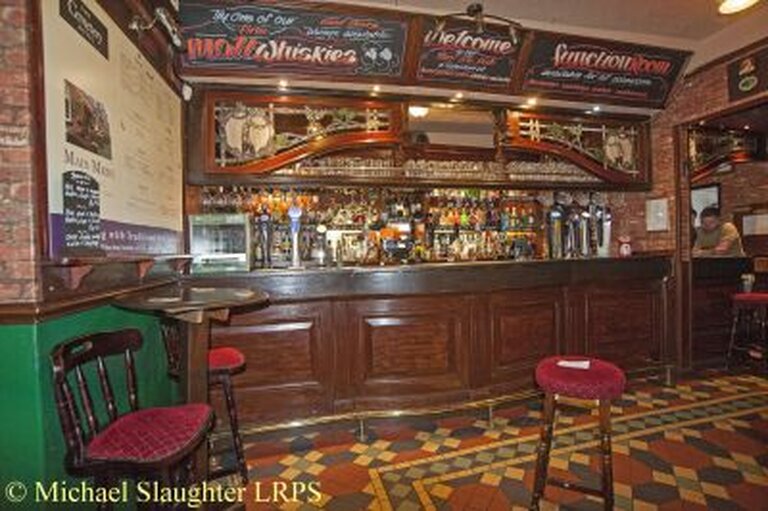
This is a late Victorian pub with lots of original decorative tiling. There are three rooms. The most impressive of the three rooms is the front left Parlour with '2' on the door. It is expensively fitted and includes very good seating. There are four seating areas created by substantial part glazed mahogany baffles with classical columns. Either side of the entrance door are two imposing mahogany baffles with leaded glass panels in the top part. The room has a distinctive turquoise tiled/ceramic fireplace with a good wood surround including a mirror. The room has retained an original etched front window with the wording 'Wines & Spirits'.
The Old White Lion, Bury
Three star - A pub interior of outstanding national historic importance
Listed status: II
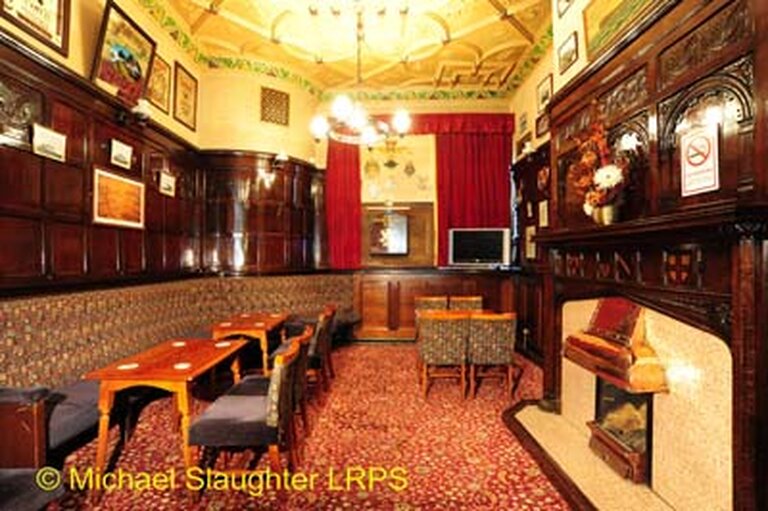
This is a three storey Victorian or Edwardian building with a revolving door that is still in use. The star here is the superb Oak Room at the rear right with an etched 'Oak Room' with lion symbol in the door. This small room has quality panelling from the period 1910-20? including decoratively carved panels at the top and a splendid Tudor arch shaped fireplace with tiles and carved wood including a three sectioned carved panel above the mantleshelf. The decorative plaster ceiling includes Tudor rose symbols, unicorns, stags, cockerills, animal faces and birds in relief and some coats of arms; also a cornice of grape vines recently picked out in colour. The Oak Room is not always open so it is best to ring 0161 764 2641 in advance of a visit to check you will be able to get access.
The Grapes, Heywood
Three star - A pub interior of outstanding national historic importance
Listed status: Not listed

This is a 1920s estate pub still with a substantial majority of its floorplan and fittings intact. The door from the car park leads into a lobby with turquoise tiles from floor to ceiling and mosaic floor. Through the inner door is a lobby bar which retains its original bar counter with a new top and two heating pipes around the base; and bar back with some modern additions. There are two remarkably surviving 1920s part leaded screens around both the doors to the gents and ladies - very rare. There is another short L-shaped screen around a phone 'booth'. The porch on this side also has tiled walls and mosaic floor.
The Royal Oak, Oldham
Three star - A pub interior of outstanding national historic importance
Listed status: II

UPDATE NOVEMBER 2023 The pub has been closed by owners Inglenook Inns and sold to persons unknown. The interior has already suffered flood damage due to clumsy removal of a dishwasher. Any significant internal alterations require Listed Building Consent. The Council is keeping a close eye on the situation.
An early 20th century brick building which had a quality refitting in 1928 including the insertion of a splendid glazed servery and lots of wall tiling. The inner lobby and Lobby Bar area have inter-war tiled walls, some covered by wallpaper due to damage to the tiling. The star here is the rare intact fully screened curved servery reaching up to the ceiling where the lower panels can still be lowered but are kept in the raised positionn. The servery area is little altered with some drawers in the curved bar back and even some tiling on the walls. Note the old bell box but there are no signs of bell pushes. On the right of the lobby on Union Street side a door leads to a small Vault This has a small bar, more like a hatch, with a further section of the shuttered servery and here the lower section is still raised and lowered on a daily basis - very rare! The inter-war fixed seating has baffles near the door, and there is a small wood surround fireplace from the 1920s but is disused. On the left side of the pub the front Commercial Room and rear Snug have been knocked into one and some original (i.e. c.1900) fixed seating remains at the front. Note the fine 'Royal Oak' inter-war etched windows on the front and rear windows. The combined room has lost both fireplaces and now houses a pool table. On the Rhodes Bank (right hand) side the exterior door leads into a lobby and a door leads into a rare intact off sales with 2/3rds height inter-war tiled walls, a black and white tiled floor, and a further piece of shuttered servery up to the ceiling still intact with the lower section permanently closed. There is a splendid mahogany partition wall with glazed panels at the top that separates the off sales from the lobby bar with a door leading into the latter. Tiling continues up the open staircase and there is a good stained and leaded window on the first floor. Upstairs is a function room which retains a rare counter screen - few first floor bars retain old fittings. There are inter-war fireplaces (blocked-up) at each end of the room.
The Old Cross Inn, Radcliffe
Two star - A pub interior of very special national historic interest
Listed status: Not listed
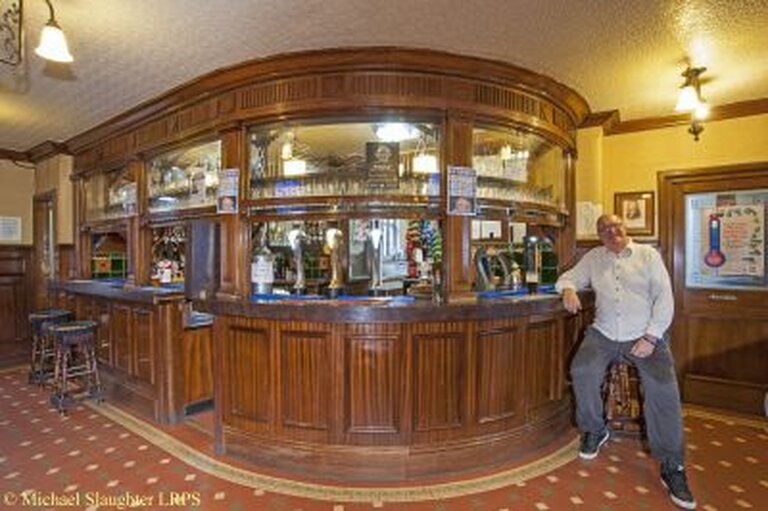
Dating from around 1897, the Old Cross was renovated by Holts in about 2000 but it still retains a good deal of its original fittings and layout. The lobby bar has a splendid screened servery still complete with lower sections that can be raised and lowered (including a curved one). On the left the tap room and the news room have been combined but retain fixed seating and baffles with inter-war etched panels in the top of them, also signs of the old bell-pushes around the rooms. On the right the music room is now a pool room but retains original fixed seating re-leatheretted with bell-pushes in the wood panel above.
The Bridge Inn, Rochdale
Two star - A pub interior of very special national historic interest
Listed status: Not listed
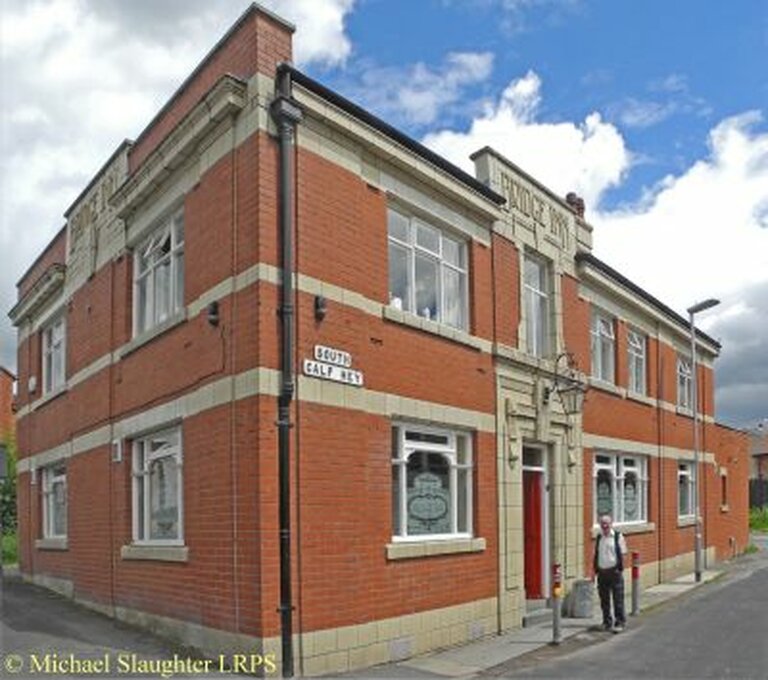
Known as 'The Bridge in the Alley', this is a tucked away red brick building with five rooms and many original fittings. The lobby has a dado of inter-war light blue tiles. The inner twin doors - right with original etched panel, left with replacement panel - lead to the lobby bar with a black and white tiled floor, inter-war tiled dado and glazed screened servery which has lost its lower panels. The bar back fitting is good featuring some old mirror panels but does not look old/original e.g. the cupboards look new. Ladies' and gents' on the rear right have interwar etched 'Gents' and 'Ladies' panels in the doors, original tiled floors but modern tiled walls. In the front middle right a doorway leads to a small original parquet floor room with what looks like old/original fixed seating (but this is a Samuels Smith's pub!), a cast iron fireplace looks modern but the tiles on the floor and the wood surround aloof old; it has replacement 'Bridge Inn' etched windows.
On the front left a doorway leads to a small room with carpet on a screeded floor, what looks like old/original fixed seating (but this is a Samuels Smiths pub!), the wood surround and cast-iron fireplace is a recent addition but the brick shaped floor tiles and wooden border do look old and there are modern bell-pushes. The rear left small room also has a doorway, old/original fixed seating re-upholstered, a hatch to the side of the servery which looks more modern than old, new bell-pushes, and has lost its fireplace. On the front far right a doorway leads to a small room which has been brought into pub use with no fixed seating but original 'Bridge Inn' window, old cupboards in the corner, and no sign of a fireplace. It won a Conservation Award in the 1994 CAMRA/English Heritage Pub Design Awards.
The Two Tubs, Bury
One star - A pub interior of special national historic interest
Listed status: II
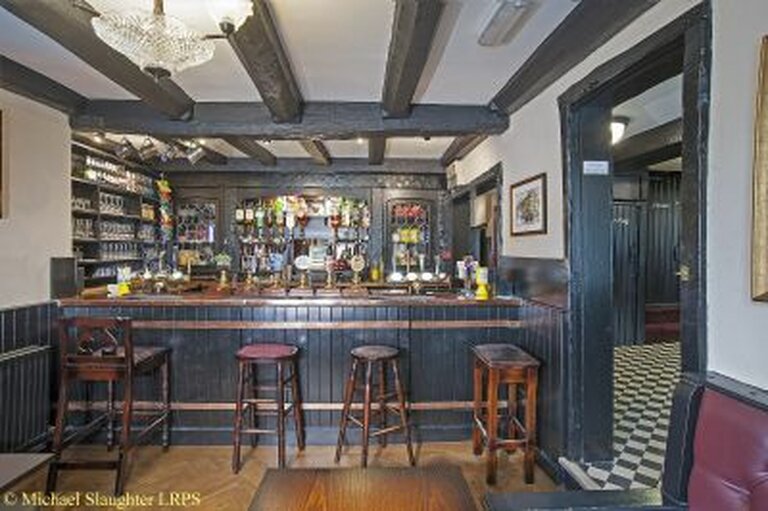
Possibly 18th century (a metal water spout has 'IBM 1747') pub of brick and render that despite enlargement retains small rooms at the front with fittings from around 1960. From the front door a passage runs to the rear with old fielded panelling to two-thirds height all along (some similar panelling may be more modern) and a counter to the front left room servery with a copper top. A doorway leads to the small front left bar with a 1960s lino tiled floor, a bar counter front with barrel staves brass straps and a copper top - a popular early 1960s style. The bar back fitting has a Tudor shaped arch central section and display cases with leaded glass windows which could be from the 1930s? The fixed seating could well be at least 50 years old but the dado panelling could be more modern.
From the passage a wide gap on the right leads to two small rooms that may have been combined in the 1960s. It has fielded panelling to two-thirds height all around both areas, good fixed seating (dated?), and a small fireplace on the right hand wall. Further down the passageway on the right is a snug with a door, more good fielded panelling to two-thirds height, and what looks like a 1950s radiator. There is a small alcove on the rear left of the passageway. In the large rear room in the extension there is a small area at the front left of some character with half timbered exposed wall.
The Duke of Wellington, Heywood
One star - A pub interior of special national historic interest
Listed status: Not listed
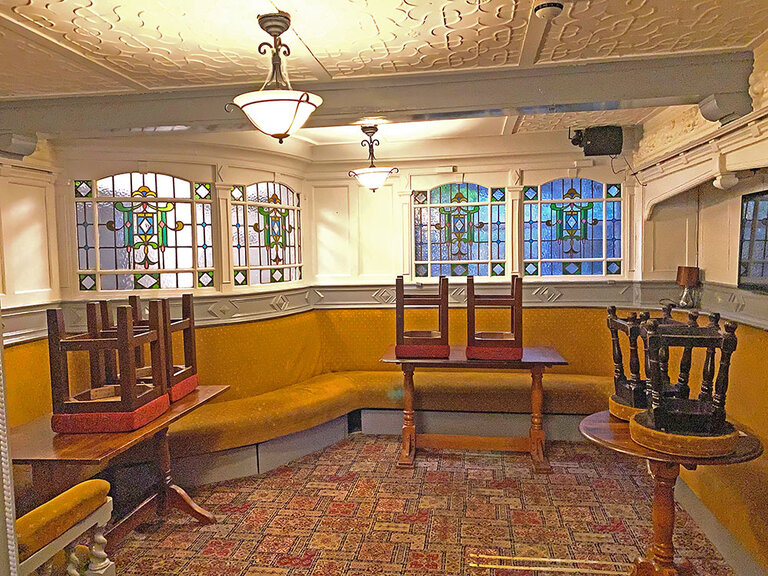
The Duke of Wellington is well worth a visit to see the splendid baronial-style lounge which is largely intact from its creation in the 1930s. It lies through a doorway to the right of the public bar and it is entered between two fine timber and glass screens. All around the room are benches with bench ends featuring barley-twist columns and some old panelling above. The room appears to have completely panelled walls but actually the top section is a clever design consisting of painted strips of timber on plaster walls. Over the ‘panelling' either side of the fireplace is what look like inglenook-style canopies. What seems to be a plaster frieze with decoration of fruits and leaves is actually a plastic mould - just tap it and you realise it is hollow!
There is a fine plasterwork ceiling, and a 1930s timber fireplace with ornate canopy-style mantelpiece which, unfortunately, has a reproduction Victorian-style fireplace. The original stained glass windows remain at the rear but those at the front have nearly all been replaced with plain windows. The light fittings are recent and rather over the top while the carpet is truly horrid but perhaps protects something interesting. A TV screen has been bolted onto the panelling but is relatively unobtrusive and could easily be removed. In 2022, the room was redecorated with a scheme that detracts significantly from the atmosphere of the room.
The Royal Oak, Werneth, Oldham
One star - A pub interior of special national historic interest
Listed status: Not listed
This pub is closed long term - Planning permission granted in December 2023 for conversion to house of multiple occupation.
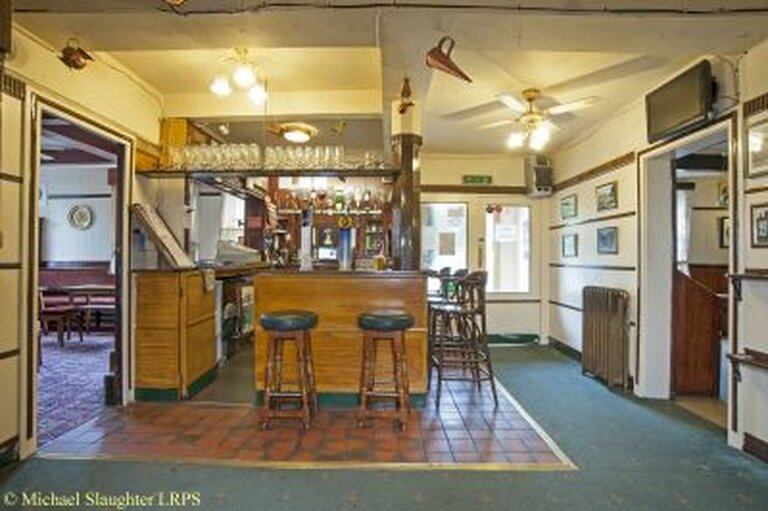
A little altered four room and drinking lobby / hallway pub. Built in 1824, it was extended in 1888 and the toilet block was added in 1937 when the pub underwent a refurbishment. Walk into the lobby bar, an L-shaped room where both the two sides of the servery and the walls have similar (inter-war?) panelling that was originally dark wood but now stained/painted a light/yellow colour. The lobby has inter-war panelling to 3/4's height, a bar back of shelves of no great age attached to (ply) panels possible of the 1970s and Formica bar tops. A door on the front right leads to a small room with another side of the servery but the counter front is modern (1970s?) and maybe was previously a hatch?
It retains fixed seating probably from 1888 with signs of bell-pushes and has small round Formica top tables but has lost its fireplace. The rear right small room has a doorway, original fixed seating with bell pushes above, more Formica topped tables, but has lost its fireplace and what looks like c.1970s panels cover the walls. There is a section of wall removed between front right and rear right rooms 'for supervision'. The rear left small room retains its door, original fixed seating with bell pushes above, the old wood surround fireplace has been blocked up with an electric fire in front and more Formica top tables.
The front left room has a door, a lino tiled floor, original wood backed, upholstered seat fixed seating (all other fixed seating is upholstered) around the room but no bell-pushes and the fireplace is blocked-up. Note the figure '4' on the door to the cellar. Door handles are likely to be from 1927. Gents' has three old-style urinals but has lost its 1930s tiling.
The Flower of the Valley, Rochdale
One star - A pub interior of special national historic interest
Listed status: Not listed
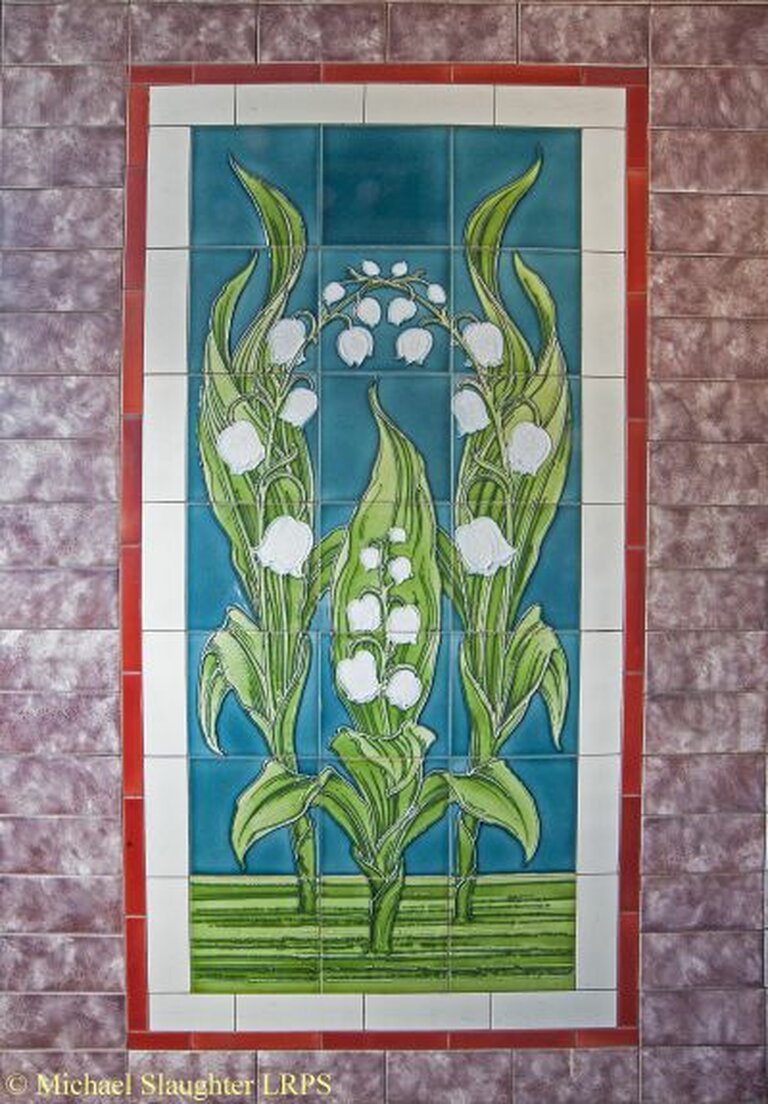
Much survives of what is probably an Edwardian layout and associated fittings. At the front entrance porch there is a mosaic floor, tiling on the walls both sides and on the left a lovely ceramic panel showing lily of the valley. The core is a lobby bar with a black and white tiled floor and off which three rooms and one area lead. The servery at the rear has a quarter-circle counter which looks old with modern panels on its front. Above are four etched and frosted panels so this may have been a shuttered bar in the past. All four were covered over for many years and re-exposed in 2015 - the third panel is a replacement. The bar back fittings may be old. The wood panelled space at the rear right has been opened up as there is some modern wood block strips indicating there was a wall / partition here originally. This area has lost its fireplace.
There are two rooms at the front and at the rear left is a delightful small snug. The front left-hand room has a widish doorway still with an etched panel above it, old fixed upholstered bench seating all round and a simple fireplace with modern red tile surround. The curved edging to the lobby tiled floor indicates a circular entrance to the room originally. The front right-hand room (used for pool) has a doorway with an etched panel above, fixed slatted wood bench seating (with padded seats), parquet floor but the fireplace appears to have been removed at some stage.
The small rear left-hand room has 'Snug' in the top panel in the door, old fixed upholstered bench seating and what appears to be a retro metal surround fireplace. There is a fine display of etched Art Nouveau-style window glass but most only date from 2015 with only the centre one on the left is old.
The Kingsway Hotel, Rochdale
One star - A pub interior of special national historic interest
Listed status: Not listed
This pub is closed long term

Situated on the edge of Rochdale and close to 1930s housing, this red brick pub with some Art Deco styling in stone at the top was opened by the Rochdale & Manor Brewery Limited on Friday 7th October 1938 – see framed details on the wall near the servery - (Samuel Smiths bought the brewery in 1947 but brewing continued at Rochdale until 1974). It has a four rooms and also a further room upstairs and it very little altered with only the off-sales removed – it looks like it may have been replaced by a disabled toilet?
The entrance on Kingsway retains its original revolving door and mosaic floor. It leads to a large lobby bar with parquet floor, plain skylight, original fixed seating at the front on either side of the revolving door. The bar counter is the original with a distinct mainly horizontal panelled front, a top that has been replaced at some time, and the original 1938 bar back fitting with etched and frosted glass panels. The room has a panelled dado and also an unusual wide strip of horizontal panelling in similar style to the bar counter front. Note the ‘Ladies Toilet’ and ‘Gents Toilet’ frosted and etched panels in the doors – the gents has a black and white tiled floor, inter-war tiled walls and three original urinals; the ladies retains much of its original inter-war tiling.
A door on the front left has a ‘parlour’ etched and frosted panel, a carpet over the parquet floor, original fixed seating, a good 1930s looking fireplace (but was introduced in 2015) with tiles & wood surround and a coal fire and another wide strip of mainly horizontal original panelling. There is an odd space on the left hand wall with no fixed seating and now contains a radiator - there was a dart board here in the past. There is a disused door on the Milnrow Road side which leads to a passage with mosaic floor, then a parquet floor.
Off the passage the rear right room has a ‘Public Bar’ in an etched and frosted panel in the door, a parquet floor, original fixed seating, a tiled and wood surround fireplace, a small original bar counter with vertical panels, the bar back fitting looks like the original - the mirrored section at the top certainly does – but it is not in use. There are etched and frosted ‘Ladies Toilet’ and ‘Gents Toilet’ panels on both doors from the public bar and the inner doors, the gents’ has black and white tiled floor, original urinals but modern wall tiling, and the ladies retains original inter-war wall tiling.
In the passage twin doors with ‘Lounge Bar’ in etched and frosted panels lead to a large room on the front right of the pub where the parquet floor was revealed in 2015 and has some fixed seating but some removed in 2015 as this is now a dining room. There is a 1930s tiled and wood surround fireplace, an original bar counter with vertical panels and handpumps removed from the top, the original bar back fitting with mirrored panels is also not in use.
There is an entrance on the left hand side of the building with two doors – the left hand door seems to lead to what is now a kitchen in a flat roofed extension. The right hand door leads to a passage with mosaic floor as your enter and in this area is a disabled toilet with a ‘Disabled Ladies Toilet’ panel in the style of the original 1938 ones elsewhere. Upstairs there is a function room with a parquet floor and a counter that is similar in style to the others but looks modern; the bar back fitting is also modern and there is lots of 1930s frosted windows. The full sized snooker table is claimed to be the one used for the 1978 World Snooker Championships.
The Royds Arms, Rochdale
One star - A pub interior of special national historic interest
Listed status: Not listed
This pub is long term closed

Has a layout of lobby bar and three small rooms with some impressive tile work. Entrance lobby has floor to ceiling tiling with a tiled frieze at the top. The middle of the wall has a tiled painting of a Phoenix on both sides reflecting that this was a Phoenix Brewery of Heywood pub.
The lobby bar has a modern tiled floor and a tiled dado all around the walls and also on the bar counter front with some tiled panels. The bar back fitting dates from the early 1980s. The front right small room has a 'Tap Room' inter-war stained glass panel in the door, old, possibly inter-war fixed seating and service via a hatch to the servery, but it has lost its fireplace.
Front left room has a doorway, modern dado panelling but has lost its fireplace and houses a pool table. There is a wide gap between the front left and rear left room, which has a doorway entrance from the lobby bar. The fixed seating maybe from inter-war times, there is a modern stone fireplace and good ceiling rose.
The Dungeon Inn, Tottington, Bury
One star - A pub interior of special national historic interest
Listed status: Not listed
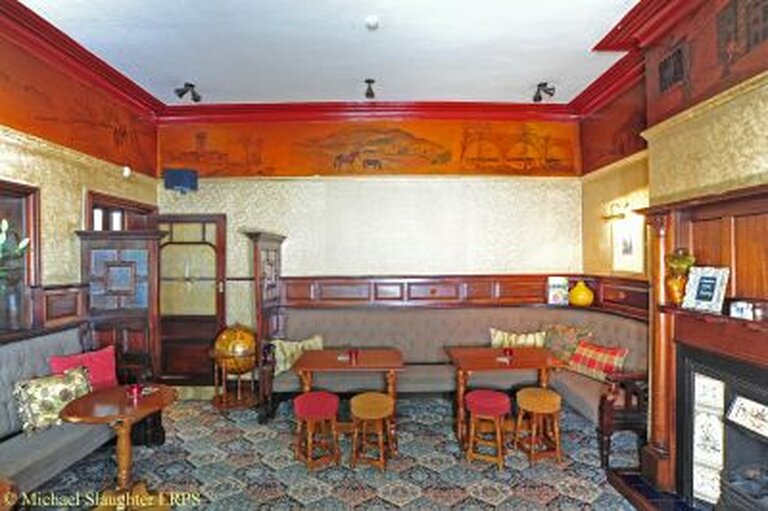
Re-built 1904 in brick and stone by the Bury Brewery with an imposing exterior featuring the wording “Old Dungeon Inn” and “Bury Brewery Co. Ales And Stout” in stone at the top. The name comes from Tottington's 'Dungeon' - actually a lock up built 1835 and situated just around the corner. The entrance porch, architraves around doorways, the walls going upstairs and around the upper landing, the end of the corridor and the entrance room to the Gents' are tiled in the most magnificent colourful Victorian glazed tiles by Pilkingtons which are in excellent order. The tiles are of the same design as at the Hark to Towler, a stylised sunflower, and the way that they have been placed on the diagonal joins is just brilliant. The upper frieze of fruit and swags was probably designed by A J Kwiatkowski at Pilkingtons. The pub also has faience door surrounds.
The inner door is situated in a screen with etched side panels and stained & leaded panels at the top. The bar is situated on the left in what was originally two small room that have been combined with the corridor and the bar fittings are modern, as is the tiled and wood surround fireplace in the rear part but there is some old fixed seating in the front part.
Of particular interest is the front right snug where all fittings appear to be intact - benches all round, two draught screens, panelling above with bell-pushes, and an unusual old fireplace. The spectacular feature is the area above the picture rail, which has wall paintings highlighted by floodlighting, and is a remarkable feature. An artist, who was living in Tottington as an evacuee, was commissioned to paint the mural/frieze in about 1945. It depicts life in Holcombe and Tottington in the 1940's showing local villages, landscapes and horse racing events. Over the decades, this has become rather brown and it desperately needs some TLC to bring back up to its former glory. The snug is not 100% intact, as there is a rectangular hole in the wall to the corridor.
At the rear right is the games room with original bare fixed seating all around the room but plain windows replaced original etched ones in 2013 as the frames were rotten. The gents at the rear right has plain original wall tiling throughout and old urinals, but there has been some damage to tiling and present landlord hopes to be able to replace them with good replica tiling. The ladies was originally a store room and also has tiling around the doorway.
The Welcome, Whitefield
One star - A pub interior of special national historic interest
Listed status: Not listed
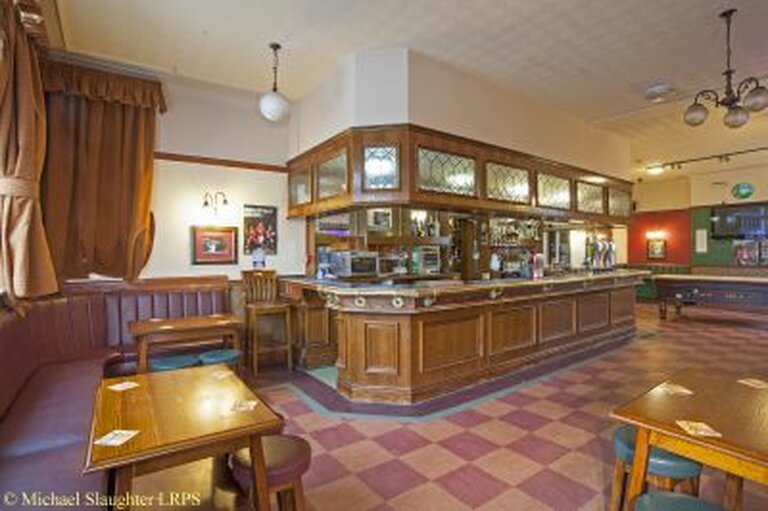
Built in 1936. Brick and half timbered exterior. The Bar Parlour on the right has a blocked up door which was the off -sales that ran down the middle of the present room i.e. it was a bar and a snug until it was all knocked into one in the 1980s. Good bar fittings - the bar back may be some old cabinet and doorway between two parts is 1930s but much new shelves, tiles etc. Original fixed seating at the front of the room. Gents here has old urinals but modern tiles. The main bar has fully panelled walls to picture frame height, a very good glazed stone and wood surround fireplace but fixed seating may be post war. The original bar counter with leaded panels reaching to the ceiling but a new counter top and the bar back is a mixture of old and new - all the lower shelves replaced by fridges. Dado panelling up the staircase to? Original revolving door replaced by exterior and inner doors but the curved panelling around it survives. The small lounge has a good carved wood surround fireplace from the 1930s but modern tiles and fixed seating may be original. The intact gents on the left were removed in 2009.
As well as maintaining the National Inventory of Historic Pub Interiors, CAMRA's Pub Heritage Group is working on a series of regional Real Heritage Pub Guides, which include many other excellent pubs which, whilst altered, still have significant historic or architectural value. Click the link to find more heritage pubs up and down the country.Pub Heritage
If you want to help research heritage pubs, this link Heritage pubs. Getting involved. provides more information.
Regular bulletins are provided on topics relating to the Pub Heritage work, and this link Heritage Pub bulletins. will show you more.
Click here Heritage Pubs Publications to see the books available in the CAMRA Shop
